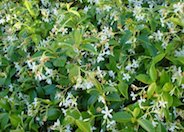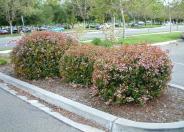
Common name:Sago-Palm
Botanical name:Cycas revoluta
Sago Palm resembles small palms; it is evergreen. It can slowly grow to 10'. It is used for a tropical effect and also looks great in planters. In the low desert, light shade and additional moisture are best. Side sprouts can form multi-trunked individuals. Apply fertilizer at leaf expansion. This plant has few pests.

Common name:Star Jasmine, Maile Haole
Botanical name:Trachelospermum jasminoides
The Star Jasmine is an evergreen vine that grows 20' tall or as a groundcover that reaches 1'-2' tall and 4'-5' wide. It has white fragrant flowers in the summer and can tolerate sun or partial shade. The Star Jasmine is also drought tolerant. -Cornflower Farms

Common name:Indian Hawthorne or Rhaph
Botanical name:Rhaphiolepis indica
This small shrub will grow 2' tall and 4' wide. It has small, dark green leaves that get a red tint in the winter and deep pink flowers that bloom fall through spring.

Common name:Mondo Grass, Lily Grass
Botanical name:Ophiopogon japonicus
This Ophiopogon japonicus is a grass-like plant growing to about 6"-8" high. Its leaves are 1/8" wide, and about 8"-12" long. It makes a beautiful ground cover or accent plant, and does well in Asian style gardens.

Common name:Golden Bamboo, Fish Pole Bamboo
Botanical name:Phyllostachys aurea
This Bamboo will grow to about 25' tall and is drought tolerant with dense foliage. This running bamboo needs to be restricted or confined.

Common name:Loquat
Botanical name:Eriobotrya japonica
Eriobotrya japonica is an evergreen tree that grows 12'-25' tall and 12' to 30' wide with large green leaves. It requires average, well- draining soil, with half to full sun, and low to medium watering. White flower clusters bloom in winter, followed by yellow, melon-tasting oval fruits in spring. It needs afternoon shade in desert areas to prevent leaf burn. Water deeply to remove salts and promote more fruit.
| Designer: Huntington Gardens | Huntington Chinese Garden 26 |
Photographer: GardenSoft |
Soils and Compost:
Physical weed control, including mulching, or hand removal protects the watershed from harmful chemicals.
Water Saving Tip:
Mulching and adding compost to soil can minimize evaporation and help soil absorb and store water.
Integrated Pest Management:
Remove irrigation water and fertilizer from areas where you don't want weeds to grow.
